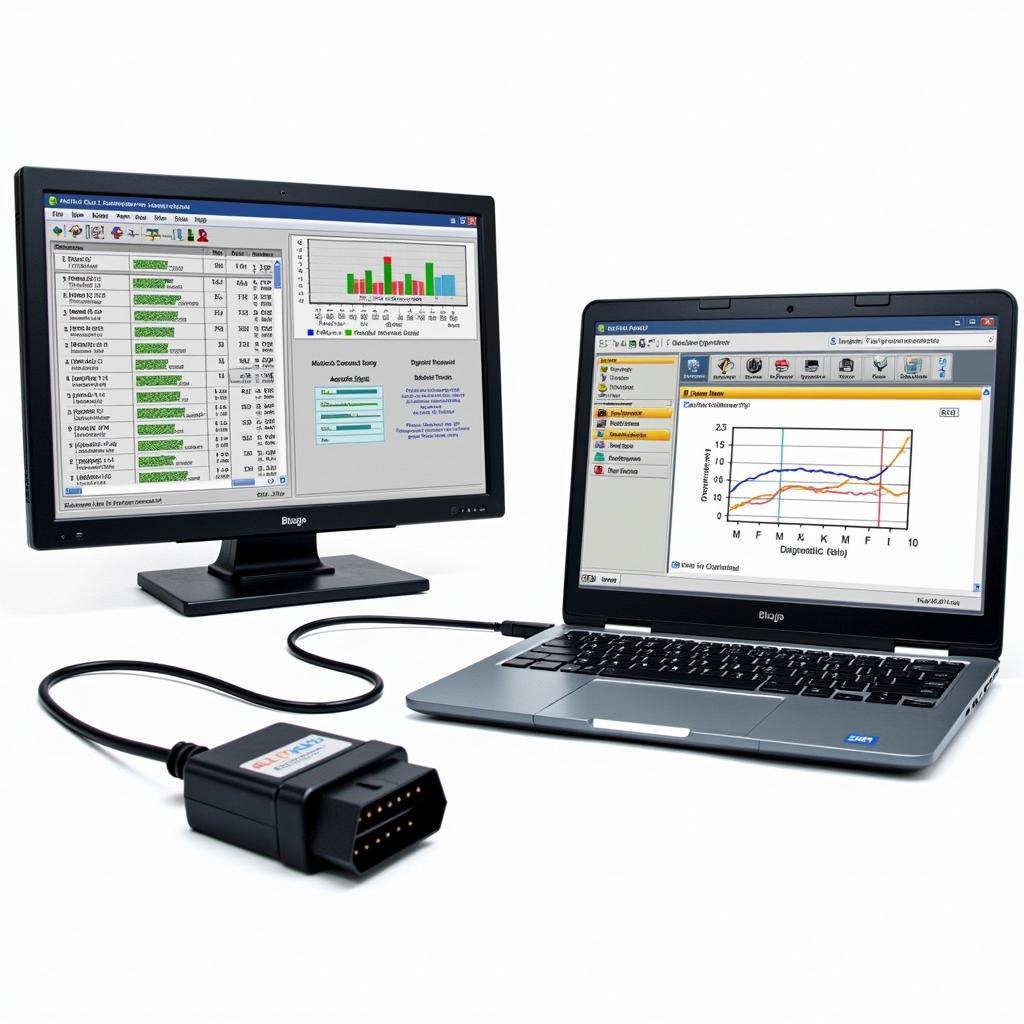PC diagnostic software for cars has revolutionized the way mechanics troubleshoot and repair vehicles. Gone are the days of relying solely on experience and intuition. Today, with the right software, you can pinpoint issues with incredible accuracy, saving both time and money. This guide will delve into everything you need to know about PC diagnostic software, from choosing the right software to understanding its capabilities and maximizing its potential.
Understanding the Need for PC Diagnostic Software
Modern vehicles are complex machines, packed with sophisticated electronic control units (ECUs). These ECUs manage everything from engine performance and transmission shifting to safety features and comfort controls. When a problem arises, pinpointing the source can be like searching for a needle in a haystack. That’s where PC diagnostic software comes in. It acts as a bridge between your computer and the vehicle’s ECUs, allowing you to access a wealth of diagnostic information. This information can include real-time data streams, fault codes, and even historical performance records.
Benefits of Using PC Diagnostic Software
Using PC diagnostic software provides a multitude of benefits, including:
- Accurate Diagnostics: Quickly and accurately identify the root cause of vehicle problems.
- Time Savings: Eliminate the guesswork and reduce diagnostic time significantly.
- Cost-Effective Repairs: Avoid unnecessary part replacements by precisely identifying faulty components.
- Enhanced Customer Satisfaction: Provide faster, more efficient repairs, leading to happier customers.
- Stay Up-to-Date: Access the latest diagnostic information and keep pace with evolving vehicle technology.
Choosing the Right PC Diagnostic Software for Cars
The market is flooded with various PC diagnostic software options, each with its own strengths and weaknesses. Choosing the right one can be overwhelming. Here are key factors to consider:
- Vehicle Compatibility: Ensure the software supports the makes and models you work on. Some software is specialized for specific manufacturers, while others offer broader coverage.
- Features and Functionality: Consider the specific features you need, such as live data streaming, bi-directional controls, and advanced diagnostics.
- User Interface: Opt for software with a user-friendly interface that’s easy to navigate and understand.
- Updates and Support: Choose a reputable vendor that provides regular software updates and reliable technical support.
- Cost: PC diagnostic software prices range from affordable to premium. Consider your budget and the features you require.
Key Features to Look For:
- Code Reading and Clearing: The ability to read and clear diagnostic trouble codes (DTCs).
- Live Data Streaming: View real-time data from various sensors and systems.
- Bi-directional Controls: Actively control various components for testing purposes.
- Component Activation: Activate components like fuel injectors or solenoids to pinpoint malfunctions.
- Adaptation and Coding: Perform advanced functions like ECU coding and key programming (for qualified technicians).
Maximizing the Potential of Your PC Diagnostic Software
Simply owning the software isn’t enough. To truly maximize its potential, consider the following:
- Training and Education: Invest in training to understand the software’s full capabilities and how to interpret the data it provides.
- Regular Updates: Keep your software up-to-date to ensure compatibility with the latest vehicle models and diagnostic protocols.
- Data Interpretation: Learn how to effectively analyze the data provided by the software to accurately diagnose problems.
- Integration with Other Tools: Integrate your diagnostic software with other tools, such as oscilloscopes and multimeters, for comprehensive diagnostics.
“Effective diagnostics is about more than just reading codes. It’s about understanding the data and using it to solve complex problems,” says John Miller, Senior Automotive Diagnostician at Advanced Auto Solutions.
Conclusion
PC diagnostic software for cars is an essential tool for any modern mechanic. It empowers technicians to diagnose vehicle problems accurately and efficiently, leading to faster repairs, reduced costs, and increased customer satisfaction. By choosing the right software, investing in training, and understanding its capabilities, you can transform your diagnostic process and stay ahead in the ever-evolving automotive industry. Investing in PC diagnostic software for cars is a crucial step towards providing top-quality service and maintaining a competitive edge.
FAQ
- What is OBD-II? OBD-II stands for On-Board Diagnostics, Second Generation. It’s a standardized system that allows access to a vehicle’s diagnostic data.
- Is PC diagnostic software suitable for DIY car repairs? While some software is designed for DIYers, complex diagnostics require professional training and experience.
- How often should I update my diagnostic software? Regular updates are essential to maintain compatibility with new vehicle models and access the latest diagnostic features.
- What are diagnostic trouble codes (DTCs)? DTCs are codes that indicate specific malfunctions within the vehicle’s systems.
- Can PC diagnostic software program new keys? Some advanced software allows for key programming, but this usually requires specialized training and authorization.
- How much does PC diagnostic software cost? The cost varies depending on the features and capabilities, ranging from a few hundred to several thousand dollars.
- Can I use any laptop with diagnostic software? Most software has minimum system requirements, so it’s essential to check compatibility before purchasing.
Common Diagnostic Scenarios
- Check Engine Light Diagnosis: One of the most common uses of PC diagnostic software is diagnosing the cause of a check engine light.
- ABS System Troubleshooting: The software can be used to diagnose problems with the Anti-lock Braking System (ABS).
- Transmission Diagnostics: Diagnose issues with automatic and manual transmissions.
- Airbag System Diagnostics: Diagnose problems with the airbag system, including sensor faults and deployment issues.
Further Reading and Related Topics
- OBD-II Port Location Guide
- Understanding Diagnostic Trouble Codes (DTCs)
- Automotive Oscilloscope Basics
Need assistance? Contact us via WhatsApp: +1(641)206-8880, or Email: [email protected]. Our customer service team is available 24/7.



